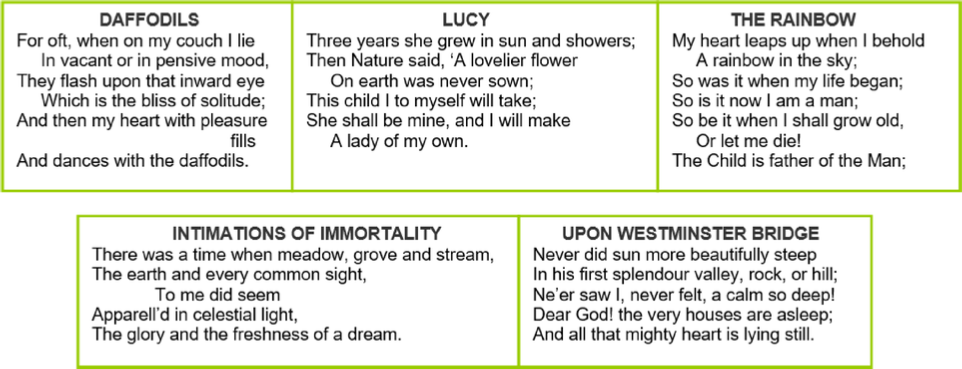


xxxxxAs we have seen, it was in 1789 (G3b) that the English poet William Wordsworth, in collaboration with Samuel Taylor Coleridge, produced Lyrical Ballads, a work which included his Tintern Abbey and launched the English romantic movement. Most of his poetry from then on was a reaction against the stilted, artificial style of Neoclassical verse. Wordsworth argued that poetry should appeal to the senses, and that the subject matter and the language used should be within the experience and understanding of ordinary people. Above all, he awakened his reader to the beauty of nature, maintaining that poetry stemmed from “emotion recollected in tranquillity”, and was the means of recapturing the experience of the senses. Among his simple but beautiful lyrics were Daffodils, Lucy, The Solitary Reaper, To the Cuckoo and Upon Westminster Bridge. His more philosophical works included Tintern Abbey, The Prelude, and his Intimations of Immortality, a work included in his collection of Poems, published in 1807. These were poems of reminiscence, aiming to recapture the “celestial light” of his childhood, and concentrating above all on the growth of his imagination and its increasing power over both reason and the senses. He was born and spent much of his lifetime in the Lake District with his family and sister Dorothy. He was made Poet Laureate in 1843 and, apart from Samuel Taylor Coleridge, his wide circle of friends included the writers Robert Southey, Walter Scott, Charles Lamb, William Hazlitt and Thomas De Quincey.
WILLIAM WORDSWORTH 1770 -
(G3a, G3b, G3c, G4, W4, Va)
Acknowledgements
Wordsworth: detail, by the English painter Benjamin Robert Haydon (1786-
xxxxxAs we have seen, in 1789 (G3b) the English Romantic poet William Wordsworth collaborated with his fellow poet and countryman Samuel Taylor Coleridge in the production of the Lyrical Ballads. This work, which included Coleridge’s The Ancient Mariner and Wordsworth’s Tintern Abbey, is generally taken to mark the beginning of the Romantic Movement in English poetry. Later, in 1807, Wordsworth published his own collection of Poems, and this included his Ode, Intimations of Immortality, a thought-
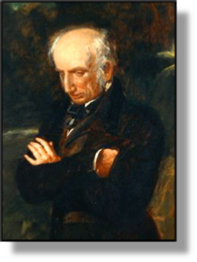
xxxxxWordsworth was born at Cockermouth, Cumberland, and it was here in the Lake District that he developed a deep love of nature, and came to appreciate the simple life of country people. Left an orphan at the age of 13, he attended Hawkshead grammar school as from 1778, and then studied at Saint John's College, Cambridge. After graduating, he paid a second visit to France and this proved productive in more ways than one. He became inspired by the ideals of the French Revolution, then in its early stages, and he also fell in love with Annette Vallon -
xxxxxThe next few years were troubled ones for the young Wordsworth. Virtually without money and with no trade to hand, he roamed aimlessly around London, opposing the war against France and wracked with guilt over the woman and child he had deserted. His first attempt at writing, The Evening Walk and Descriptive Sketches (about a walking holiday in the Alps) was published in 1793. They were not without merit but, being in the formal style of the day, they received little attention, and only a few copies were sold. Nonetheless, two years later, having received a legacy of £900 from a close friend, he decided to devote himself to poetry. There followed his tragedy, The Borderers, and the poems Salisbury Plain and The Ruined Cottage, works of social protest which echoed his pessimistic mood at that time.
xxxxxThen in 1797 all changed for the better. He was reunited with his beloved sister, Dorothy, and, after a short stay in Dorset, they moved to Alfoxden in Somerset, near to Coleridge’s home in Nether Stowey. As we have seen, this move proved the making of Wordsworth. It marked the beginning of a 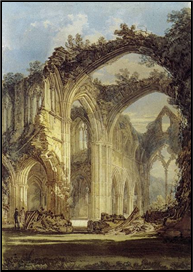 close friendship between the two poets, and in 1798 resulted in their joint production of a book of poems entitled The Lyrical Ballads, a work which was to usher in the Romantic Movement and change the face of English poetry.
close friendship between the two poets, and in 1798 resulted in their joint production of a book of poems entitled The Lyrical Ballads, a work which was to usher in the Romantic Movement and change the face of English poetry.
xxxxxThis collection of Lyrical Ballads was nothing short of an open revolt against the artificial, stilted style of Neoclassical verse. It attracted some severe criticism from the conformists, but it was a success nonetheless. On the strength of it, Wordsworth, his sister and Coleridge spent the winter of 1798/1799 in Germany, and it was here that Wordsworth produced some of his finest lyrical verses, including the elegies Lucy and Matthew and the opening draft of his The Prelude, a work of reminiscence similar to that of Tintern Abbey (illustrated). This long poem, completed in 1805 and frequently revised, contained some of his finest poetry.
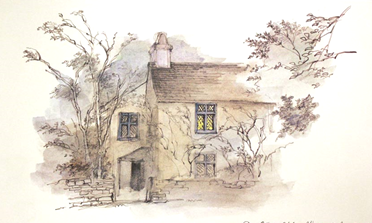 xxxxxOn their return in 1799 they were on the move again. This time they settled in Dove Cottage in Grasmere (illustrated), and the next eight years saw a continuation of his outstanding compositions, concluding with his Poems in Two Volumes of 1807. Apart from several of his well-
xxxxxOn their return in 1799 they were on the move again. This time they settled in Dove Cottage in Grasmere (illustrated), and the next eight years saw a continuation of his outstanding compositions, concluding with his Poems in Two Volumes of 1807. Apart from several of his well-
xxxxxThe year 1807 or thereabouts marked the end of his most creative years. By 1812, deeply saddened and shocked by the death of his brother John, and then two of his own children, he came to adopt a more sober, restrained style, much removed from the romantic and revolutionary zeal of his earlier days and the free rein it gave to his imagination. Furthermore, disappointed and disillusioned by the turn of events in France, and influenced no doubt by the opinions of his close friends -
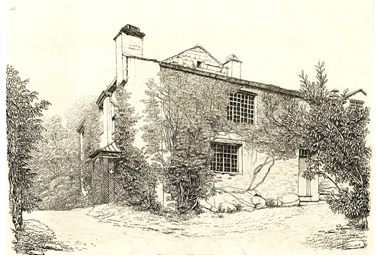 xxxxxIn 1813 he secured a job distributing stamps in the county of Westmorland, and in the same year he and his family made their last move, this time to a larger, imposing house at Rydal Mount near Ambleside (illustrated). Here he continued to write, but he also published a number of earlier works at this juncture -
xxxxxIn 1813 he secured a job distributing stamps in the county of Westmorland, and in the same year he and his family made their last move, this time to a larger, imposing house at Rydal Mount near Ambleside (illustrated). Here he continued to write, but he also published a number of earlier works at this juncture -
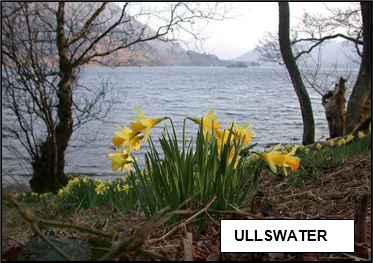 xxxxxWordsworth’s early verse -
xxxxxWordsworth’s early verse -
xxxxxBut as we have seen, Wordsworth’s poetry was not simply intended to awaken his reader to the beauty of nature, though this it undoubtedly achieved. Much of his work went deeper than that. He saw himself as a philosophical poet. He considered that by communicating with nature through the senses one could find God, and come to understand the meaning of life itself. If one listened, one was able to hear in nature the “still, sad music of humanity” because nature was wedded to the soul of mankind. And it was to provide an introspective account of his own thought processes from the days of childhood -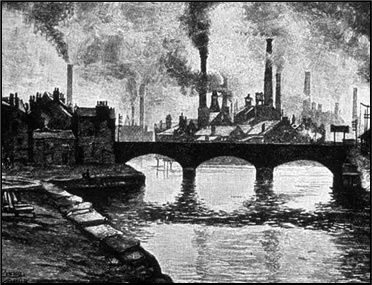 Growth of a Poet’s Mind”, traces his life from his school days to 1799, when he settled at Grasmere, concentrating above all on the growth of his imagination, and its increasing power over both reason and the senses. Likewise The Excursion, completed in 1814, was made up of nine philosophical monologues and included his earlier poem The Ruined Cottage -
Growth of a Poet’s Mind”, traces his life from his school days to 1799, when he settled at Grasmere, concentrating above all on the growth of his imagination, and its increasing power over both reason and the senses. Likewise The Excursion, completed in 1814, was made up of nine philosophical monologues and included his earlier poem The Ruined Cottage -
xxxxxWordworth’s major poems are among the finest in English literature, loved above all for their use of simple words, their description of commonplace things and events, and the beauty of their verse. His poetic theories, put into practice, created a new tradition, and made him one of the foremost leaders of the Romantic Movement. Apart from Samuel Taylor Coleridge, Robert Southey and Walter Scott, his friends included the writers Charles Lamb, William Hazlitt and De Quincey.
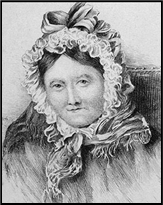
xxxxxIncidentally, Wordsworth owed much to his sister Dorothy (1771-
xxxxx…… Below are extracts from just five of his poems:
Including:
Romanticism:
Literature, Art
and Music

xxxxxThe aesthetic movement known as Romanticism was a reaction against the strictures of 18th century classicism, with its emphasis on reason, artificial traditions, restraints on form and subject matter, and its intellectual, logical approach -
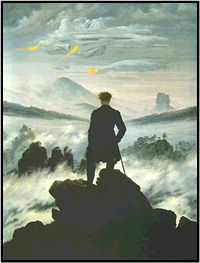
xxxxxBut the Romantic Movement that spanned from the beginning of the French Revolution to the early days of the Victorian Era (the 1840s) also brought about widespread changes in style and attitudes. It did not rely on the senses -
xxxxxIn Romantic literature, nowhere was this change more dramatic than in the field of English poetry. Here it was not a reaction against Neoclassicism but a revolt. As we have seen, William Wordsworth produced his poetic manifesto in the second edition of Lyrical Ballads in 1800, defining the principles of the English romantic movement in black and white. Poetry, he maintained, was a “spontaneous overflow of powerful feelings”. He himself exemplified this “new look” by his profound love of nature, expressed in his beautiful sonnets, whilst Coleridge, the co-
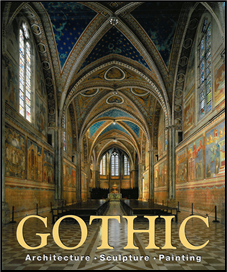 xxxxxBut though the Lyrical Ballads launched the romantic movement in Britain, it was by no means the start of this literary revolution. The English poet James Thomson, for example, had shown a deep love of nature in his Seasons as early as 1730, and this theme had been central to the works of William Cowper and Robbie Burns in the 1780s. In the meantime Oliver Goldsmith, in his Deserted Village, had revealed his deep concern for the plight of the working classes, and Thomas Gray had shown a melancholy interest in death in his famous Elegy Written in a Country Churchyard. Later the poet and artist William Blake created a visionary world in writing as well as in art with his Songs of Innocence of 1794. And romanticism was on the move in Germany as from the mid-
xxxxxBut though the Lyrical Ballads launched the romantic movement in Britain, it was by no means the start of this literary revolution. The English poet James Thomson, for example, had shown a deep love of nature in his Seasons as early as 1730, and this theme had been central to the works of William Cowper and Robbie Burns in the 1780s. In the meantime Oliver Goldsmith, in his Deserted Village, had revealed his deep concern for the plight of the working classes, and Thomas Gray had shown a melancholy interest in death in his famous Elegy Written in a Country Churchyard. Later the poet and artist William Blake created a visionary world in writing as well as in art with his Songs of Innocence of 1794. And romanticism was on the move in Germany as from the mid-
xxxxxContemporary with Wordsworth and Coleridge, and contributing to this romantic movement, were a number of literary giants. Walter Scott produced a series of narrative poems set in what he saw as the halcyon days of the Middle Ages; Percy Bysshe Shelley wrote of transcendent love in his Prometheus Unbound, produced in 1820, and John Keats, in his moving poems of this time, often dwelt a great deal upon death, suffering and decay. And Lord Byron made a contribution with his anti-
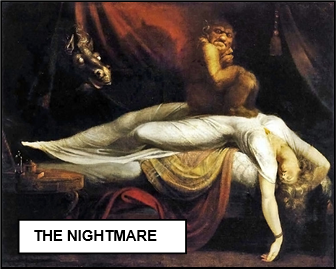 xxxxxIn France -
xxxxxIn France -
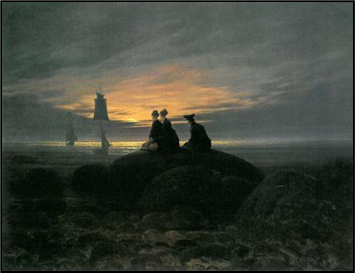 xxxxxThe romantic movement was not confined, of course, to literature. It was at work at this time in both art and music -
xxxxxThe romantic movement was not confined, of course, to literature. It was at work at this time in both art and music -
xxxxxIn Romantic music, in addition to its settings for the romantic literary themes of poems, dramas and novels, the movement was mainly characterized by an intensity of feeling, a profound love of nature, and the themes of idealism and nationalism. Among the first romantics were Weber and Schubert, and these were followed by an array of talent which included Mendelssohn, Berlioz, Chopin, Glinka, Liszt, Schumann, Verdi and Wagner. Most of these produced their major works in the first 25 years of Queen Victoria’s reign (Va), but later composers were to take the movement almost to the end of the 19th century.
xxxxxRomanticism was a reaction against the rational approach and formal structure of Neoclassicism. It laid stress on intuition and imagination, thereby leading to flights of fancy. Beginning around 1789, it showed a fascination with death, the supernatural and the exotic; fostered a deep love of nature; and felt nostalgia for the past and its heroic figures. It sought, too, the freedom of the individual, and explored the inner feelings aroused by love and despair. In Romantic literature, the English poet William Wordsworth spelled out the principles of the movement in 1800, and the principal adherents at that time were Samuel Taylor Coleridge, Walter Scott, Percy Bysshe Shelley, Lord Byron, John Keats and Thomas De Quincey. In Germany, romanticism had begun with the Sturm und Drang movement of the 1770s, but in France the major exponents came around the mid-
G3c-
